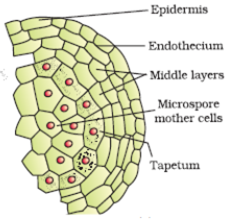Strategies for Enhancement in Food Production
Why are angiosperm anthers called dithecous? Describe the structure of its microsporangium
A typical angiosperm anther is bilobed with each lobe having two theca, thus they are called dithecous.
Microsporangium is nearly circular in outline. It is surrounded by four wall layers that is the epidermis, endothecium, middle layers and the tapetum. The outer three wall layers perform the function of protection and help in dehiscence of anther to release the pollen. The innermost wall layer is the tapetum which nourishes the developing pollen grains. Cells of the tapetum possess dense cytoplasm and generally have more than one nucleus. When the anther is young, a group of compactly arranged homogenous cells called the sporogenous tissue occupies the centre of each microsporangium.
Sponsor Area
Some More Questions From Strategies for Enhancement in Food Production Chapter
What do you mean by Pomato?
What are main advantages of cross-breeds over inbreds ?
Name two semi dwarf varieties developed in India.
What are the properties that are taken into account for improvement in biofortification?
What are somaclones ?
Name a few classes of chemical mutagens.
What is single cell protein (SCP) ?
Give examples of some micro-organisms working for SCP.
Give examples of some micro-organisms working for SCP.
Why does fisheries have an important place in Indian economy ?
Mock Test Series
Sponsor Area
NCERT Book Store
NCERT Sample Papers
Sponsor Area